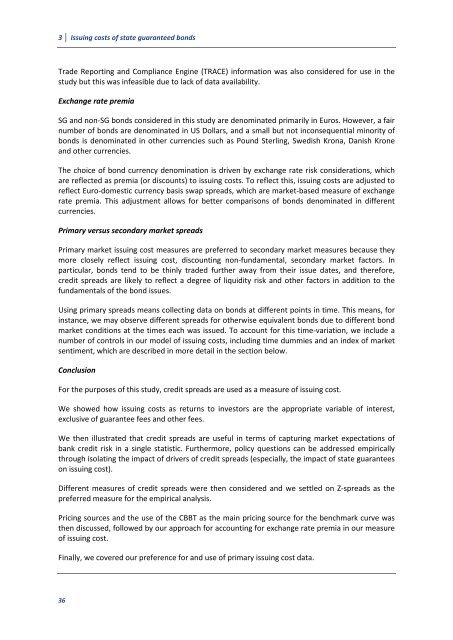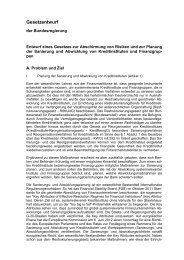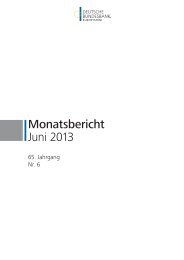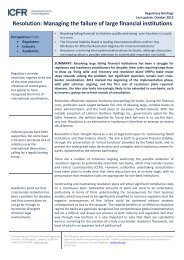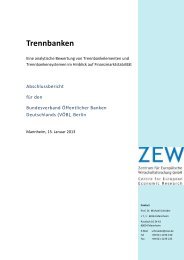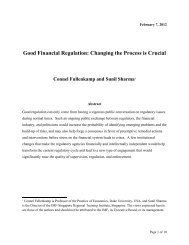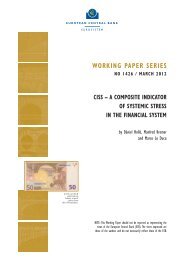3 Issuing costs of state guaranteed bonds - Financial Risk and ...
3 Issuing costs of state guaranteed bonds - Financial Risk and ...
3 Issuing costs of state guaranteed bonds - Financial Risk and ...
You also want an ePaper? Increase the reach of your titles
YUMPU automatically turns print PDFs into web optimized ePapers that Google loves.
3 <strong>Issuing</strong> <strong>costs</strong> <strong>of</strong> <strong>state</strong> <strong>guaranteed</strong> <strong>bonds</strong><br />
Trade Reporting <strong>and</strong> Compliance Engine (TRACE) information was also considered for use in the<br />
study but this was infeasible due to lack <strong>of</strong> data availability.<br />
Exchange rate premia<br />
SG <strong>and</strong> non-SG <strong>bonds</strong> considered in this study are denominated primarily in Euros. However, a fair<br />
number <strong>of</strong> <strong>bonds</strong> are denominated in US Dollars, <strong>and</strong> a small but not inconsequential minority <strong>of</strong><br />
<strong>bonds</strong> is denominated in other currencies such as Pound Sterling, Swedish Krona, Danish Krone<br />
<strong>and</strong> other currencies.<br />
The choice <strong>of</strong> bond currency denomination is driven by exchange rate risk considerations, which<br />
are reflected as premia (or discounts) to issuing <strong>costs</strong>. To reflect this, issuing <strong>costs</strong> are adjusted to<br />
reflect Euro-domestic currency basis swap spreads, which are market-based measure <strong>of</strong> exchange<br />
rate premia. This adjustment allows for better comparisons <strong>of</strong> <strong>bonds</strong> denominated in different<br />
currencies.<br />
Primary versus secondary market spreads<br />
Primary market issuing cost measures are preferred to secondary market measures because they<br />
more closely reflect issuing cost, discounting non-fundamental, secondary market factors. In<br />
particular, <strong>bonds</strong> tend to be thinly traded further away from their issue dates, <strong>and</strong> therefore,<br />
credit spreads are likely to reflect a degree <strong>of</strong> liquidity risk <strong>and</strong> other factors in addition to the<br />
fundamentals <strong>of</strong> the bond issues.<br />
Using primary spreads means collecting data on <strong>bonds</strong> at different points in time. This means, for<br />
instance, we may observe different spreads for otherwise equivalent <strong>bonds</strong> due to different bond<br />
market conditions at the times each was issued. To account for this time-variation, we include a<br />
number <strong>of</strong> controls in our model <strong>of</strong> issuing <strong>costs</strong>, including time dummies <strong>and</strong> an index <strong>of</strong> market<br />
sentiment, which are described in more detail in the section below.<br />
Conclusion<br />
For the purposes <strong>of</strong> this study, credit spreads are used as a measure <strong>of</strong> issuing cost.<br />
We showed how issuing <strong>costs</strong> as returns to investors are the appropriate variable <strong>of</strong> interest,<br />
exclusive <strong>of</strong> guarantee fees <strong>and</strong> other fees.<br />
We then illustrated that credit spreads are useful in terms <strong>of</strong> capturing market expectations <strong>of</strong><br />
bank credit risk in a single statistic. Furthermore, policy questions can be addressed empirically<br />
through isolating the impact <strong>of</strong> drivers <strong>of</strong> credit spreads (especially, the impact <strong>of</strong> <strong>state</strong> guarantees<br />
on issuing cost).<br />
Different measures <strong>of</strong> credit spreads were then considered <strong>and</strong> we settled on Z-spreads as the<br />
preferred measure for the empirical analysis.<br />
Pricing sources <strong>and</strong> the use <strong>of</strong> the CBBT as the main pricing source for the benchmark curve was<br />
then discussed, followed by our approach for accounting for exchange rate premia in our measure<br />
<strong>of</strong> issuing cost.<br />
Finally, we covered our preference for <strong>and</strong> use <strong>of</strong> primary issuing cost data.<br />
36


